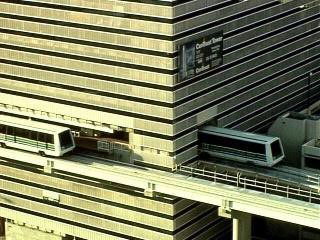Miami Metromover - The First Automated Downtown Peoplemover in the U.S.

The Miami Metromover began as a 1.9 mile (3 km) double-loop, elevated, fully-automated system designed to serve as a downtown distributor/collector for Miami's 21 mile (33.8 km) Metrorail system and as a circulator for trips between hotels, retail facilities, convention facilities and parking areas within the downtown. The concepts used to design this system are well-described in two published papers (Fialkoff, Brooks and Panama, 1989; Brooks, 1989). It is connected to the Metrorail system at a multi-level station located at the western edge of Miami's downtown. Another Metrorail connection has been provided at the Brickell Station. In FY 1990, the average daily patronage was about 12,000.
Metromover vehicles completed the initial 1.9 mile loop every 11 minutes and departed a station every 90 seconds during peak hours. There are nine stations on the initial loop and a recently completed expansion has added another 2.5 miles (4.02 km) of double-track guideway, 12 more stations and 15 more vehicles. The cost of this expansion was estimated to be $248 million or $99.2 million per mile. For comparison, the initial system cost $159 million or $84.8 million per mile. Inflation and other factors acted to increase the cost of the extensions.
The largest volume of passengers carried by Metromover is reported to be 38,000 when it moved people to/from a New Year's Eve King Orange Jamboree parade. The busiest station is at Government Center where most of the transfers to and from the Metrorail system occur.
The technology has been provided by AEG-Westinghouse and features vehicles designed to carry 82 standing and 14 seated passengers. The average speed of travel is about 12 mph (19.3 kph) as compared to 30 mph (48.3 kph) for Metrorail and 13 mph (20.9 kph) for Metrobus. Cars are equipped with rubber tires that provide a smooth, quiet ride and each is fully air-conditioned. The fare is 25 cents and a wide variety of discounts are available. Riding Metromover is free when you transfer from Metrorail. The revenue from Metromover has been quite small in relation to its costs. The farebox recovery ratio for 1989 was estimated to be around 5 percent. This very low value is due, in part, to the large number of riders who transfer from Metrorail and pay no additional fare. In 1989, the equipment and guideway maintenance, transit authority police, stockroom clerks and other labor costs were estimated to be about 47 percent of total annual costs.
Two of the current stations are integrated with office buildings. The Government Center station is part of the Metro Dade Center development and the Knight Center Station is in the fourth floor of a parking structure that is part of Centrust Tower, located adjacent to the Knight Convention Center (see photo above). The two extension legs to the north and south of the original network became operational in 1994. These extensions are projected to stimulate ridership significantly and it has been forecast to reach 43,000 by 2000.
As is well-know in transit circles, the Miami Metrorail system has not attained the ridership that was forecast for it when the initial investment decision was made. This lack of expected patronage has also contributed to the lower than expected ridership levels on Metromover. However, many new buildings have been built in downtown Miami and it is generally agree that Metromover has had a positive (though not decisive) influence on these development decisions. Although no evidence of strong public opposition to the visual intrusion of the elevated guideway in downtown Miami has been found, it has been criticized by people in other cities and may be a deterrent (in addition to its very high cost) to the deployment of similar circulator systems in other downtown areas in the future.
A route map of the Metromover network is available as are four photos of various parts of the original Metromover system. Another set of very good and recent pictures is available at another Miami DPM website.
Brooks, K.G., 1989, "Planning for the Completion of the Miami Metromover", in Automated Peoplemovers II, edited by Bondada, Sproule and Neumann, American Society of Civil Engineers:New York, 97-105.
Fialkoff, D.R., K. Brooks and A.R. Panama, 1989, "Planning Perspectives for the Miami Metromover," in Automated Peoplemovers II, edited by Bondada, Sproule and Neumann, American Society of Civil Engineers: New York, 86-96.
For additional current information contact: Miami-Dade Transit Agency
Last modified: December 23, 2014